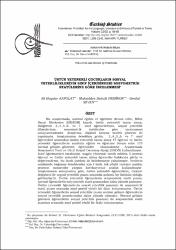Üstün Yetenekli Çocukların Sosyal Yeterliliklerinin Sınıf İçerisindeki Sosyometrik Statülerine Göre İncelenmesi
Künye
AKPOLAT, Ali Haydar, Mukaddes SAKALLI DEMİROK & Serdal SEVEN. "Üstün Yetenekli Çocukların Sosyal Yeterliliklerinin Sınıf İçerisindeki Sosyometrik Statülerine Göre İncelenmesi". Turkish Studies, 12.33 (2017): 49-65.Özet
Bu araştırmada, normal eğitim ve öğretime devam eden, Bilim
Sanat Merkezine (BİLSEM) kayıtlı, üstün yetenekli tanısı almış,
ilköğretim 3.,4.,5.,6. ve 7. sınıf öğrencilerinin, sosyal yeterlilik
düzeylerinin, sosyometrik statülerine göre incelenmesi
amaçlanmaktadır. Araştırma, ilişkisel tarama modeli yöntemi ile
yapılmıştır. Araştırmanın örneklem grubu 3.,4.,5.,6. ve 7. sınıf
öğrencileri arasından üstün yetenekli tanısı almış 47 öğrenci ve üstün
yetenekli öğrencilerin sınıfında eğitim ve öğretime devam eden 175
normal gelişim gösteren öğrenciden oluşmaktadır. Araştırmada
Sosyometri Testi ve Okul Sosyal Davranış ölçeği (OSDÖ) kullanılmıştır.
Sınıf öğretmenleri tarafından rasgele yöntemle tercih edilmiş 5 normal
öğrenci ve üstün yetenekli tanısı almış öğrenciler hakkında görüş ve
değerlendirme, bu ölçek yardımı ile belirlenmeye çalışılmıştır. Verilerin
analizinde bağımsız örneklemler için t testi, tek yönlü varyans analizi,
pearson momentler çarpım korelasyonun analizi kullanılmıştır.
Araştırmanın sonuçlarına göre, üstün yetenekli öğrencilerin, cinsiyet
değişkeni ile sosyal yeterlilik puanı arasında anlamlı bir farklılık olduğu
görülmüştür. Üstün yetenekli öğrencilerin sosyometrik statü puanı;
normal öğrencilerin sosyometrik statü puanından daha yüksek çıkmıştır.
Üstün yetenekli öğrencilerin sosyal yeterlilik puanları ile sosyometrik
statü puanı arasında zayıf pozitif yönlü bir ilişki bulunmuştur. Üstün
yetenekli öğrencilerin sosyal yeterlilik puanı normal gelişen öğrencilerin
sosyal yeterlilik puanlarından daha yüksek çıkmıştır. Normal gelişim
gösteren öğrencilerin sosyal yeterlilik puanları ile sosyometrik statü
puanları arasında zayıf pozitif yönlü bir ilişki bulunmuştur. In this study, it is aimed to examine the social competence levels of
primary education 3th, 4th, 5th, 6th, 7th class students of normal
education who have been determined as gifted and talented according to
their social status and registered to Science and Art Center.
The research was conducted using the relational scan model
method. In our study, the sample group consists of 47 students that were
determined as gifted and talented among the 3rd, 4th, 5th, 6th and 7th
grade students and 175 normal students who are educated in the same
class with gifted and talented students by thier teachers. Sociometry Test
and “School Social Behavior Scale (OSRS) were used in the study. School
Social” Behavior Scale was developed by Keneth W. Merrell in 1993 and
adapted to Turkish by Müge Yukay Yüksel in 2009.Sociometry test was
applied to the class in which gifted students were enrolled in order to
determine the social positions of gifted students in the class and their
references. In order to determine the social competence levels of the
students, the class teachers used School Social Behavior Scale (OSDÖ).
Opinions and evaluations about 5 regular students and gifted students,
who were chosen by random method by classroom teachers, were tried
to be determined with the aid of this scale. In the analysis of the data, t
test, one way analysis of variance, pearson moment correlation analysis
were used for independent samples. Significance level was taken as 05.According to the results of the research, In gifted children,
sociometric status scores were higher than normal development
students. A weak positive relationship was found between the social
competence scores of the gifted students and the sociometric status score
(preferred score). Social competence scores of gifted students were higher
than normal development students. There was a weak positive
relationship between social competence score and sociometric status
(preferred score) scores of normal development students.
Kaynak
Turkish StudiesCilt
12Sayı
33Bağlantı
https://turkishstudies.net/turkishstudies?mod=makale_tr_ozet&makale_id=21053https://hdl.handle.net/11352/3652



















